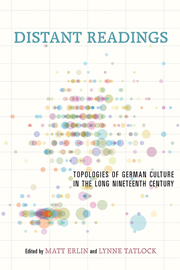Introduction: “Distant Reading” and the Historiography of Nineteenth-Century German Literature
Published online by Cambridge University Press: 05 April 2014
Summary
The sense that printed matter was piling up was not new in the nineteenth century, even if the piles were higher. In 1494, practically at the dawn of the first print revolution in Europe, Sebastian Brant for one had pilloried the spread of heresy aided by printers who, motivated by profit, “Vil drucken / wenig corrigyeren.” The total output of 1494 was, however, but a fraction of what yearly production was to become. Approximately three centuries after Brant's complaint (i.e., in the time period of interest in this volume), breakthroughs in printing technologies were helping to fuel another boom, far beyond what Brant could have imagined. From 1789 to 1918, the long nineteenth century, German intellectual life and reading culture were shaped by unprecedented newspaper, magazine, and book production that made reading material, fiction and nonfiction, available to a wider range of consumers than ever before. Nineteenth-century intellectuals, like Brant centuries earlier, were profoundly aware that the availability of texts in print was changing life forever. While some welcomed the new opportunity, others lamented accumulation and overabundance. As reading shifted from being intensive to extensive, even the most voracious reader could not read everything.
This abundance of textual material from the long nineteenth century also presents scholars with a challenge: no individual researcher can ever acquire knowledge of more than a tiny percentage of the total number of literary texts that were actually published during these approximately 150 years.
- Type
- Chapter
- Information
- Distant ReadingsTopologies of German Culture in the Long Nineteenth Century, pp. 1 - 26Publisher: Boydell & BrewerPrint publication year: 2014

